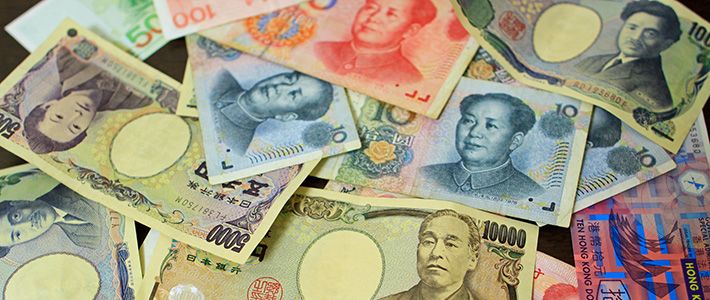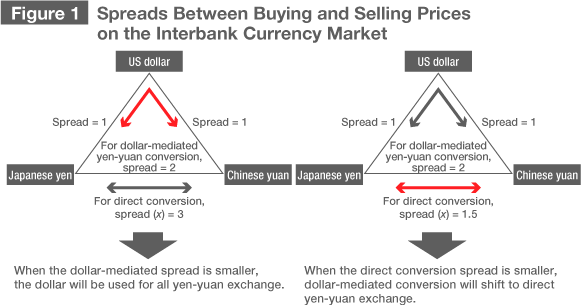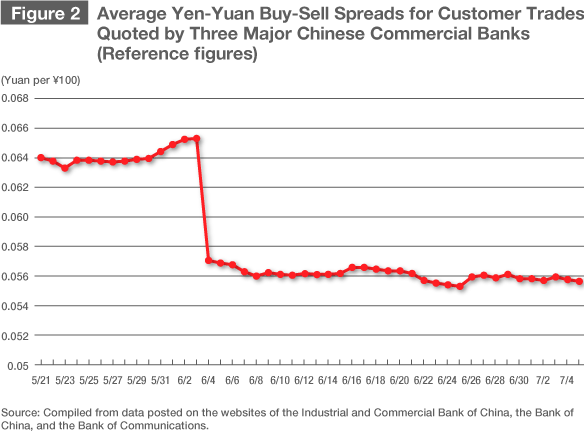
Direct Yen-Yuan Trading Gets Underway
Economy- English
- 日本語
- 简体字
- 繁體字
- Français
- Español
- العربية
- Русский
Direct trading between the yen and the yuan in interbank foreign exchange markets began simultaneously in Japan and China on June 1, 2012. This currency trading and the Japanese government’s plan to purchase Chinese government bonds are signs of deepening financial cooperation between the two countries.
The Japan-China Financial Cooperation Agreement
The December 2011 summit meeting in Beijing between Japanese Prime Minister Noda Yoshihiko and Chinese Premier Wen Jiabao produced an agreement on enhanced cooperation for financial market development between Japan and China. The agreement covers the following five points.
- Promoting the use of the yen and the yuan in cross-border transactions between Japan and China
- Supporting the development of markets for direct exchange of the yen and the yuan
- Assisting sound development of yen and yuan bond markets
- Encouraging the private sector to develop yen- and yuan-denominated financial products and services in overseas markets
- Establishing the Joint Working Group for Development of Japan-China Financial Markets to promote cooperation in these areas
The direct currency conversion that began in June was related to points (1) and (2) of the agreement and signified the realization of point (2). With respect to point (1), figures on how much of the trade between Japan and China is settled in yen, yuan, or dollars are not officially available, but it is thought that the yen is used for 30%–40% of the transactions and that the yuan is used for less than 1%. Almost all of the other deals are denominated in dollars.
In July 2009 China opened the door to the use of the yuan to settle external transactions. Its aim is to eliminate excessive dependence on the dollar and achieve a better balance in settlements by diversifying the currencies available. In the case of trade between Japan and China, for instance, there is no inherent necessity to use the dollar, a third-country currency. Deals can instead be denominated in either of the two countries’ currencies, the yen or the yuan. This is the substance of point (1).
For the time being, the yuan is not a very convenient means for settling external transactions. This is because the Chinese government, which is concerned about the effectiveness of its monetary policy and needs to control the yuan’s exchange rate, still places numerous restrictions on capital transactions and currency trading. In this light, the significance of point (1) is that it signalled China’s willingness to accept the yen’s use in transactions. If the yen-denominated share of the bilateral trade can be expanded, smaller Japanese companies in particular will be able to reduce their foreign exchange risks, which they have few means of hedging against.
Turning now to point (2), let us consider the case of a Chinese business wishing to import products from Japan denominated in yen. To pay for the deal, the Chinese importer will ask a bank to convert yuan into yen and send the yen to the Japanese exporter. In order to avoid foreign exchange risk, the bank will convert the yuan into yen on the interbank market. Until now the bank did not have the option of exchanging yuan for yen directly. It would have first sold yuan and bought dollars and next sold dollars and bought yen, thus using a two-step process. This was normal because, in the past, banks had no great need to buy and sell the yuan for currencies other than the dollar. A bank hoping to convert yuan into yen directly would have had to go in search of a transaction partner looking to buy yuan and sell yen in the same amount; a costly and complicated process. Under the circumstances, almost 100% of the yuan trading on the interbank market involved dollars. Because of the low level of need for yen-yuan conversion, this two-step process mediated by the dollar was the least expensive way to handle the conversion. Over recent years, however, trade between Japan and China has expanded, and the need for direct yen-yuan trading has greatly increased.
Now the option of direct conversion has become available, its cost may be low enough already to warrant using it in place of dollar-mediated conversion. The cost is the price banks pay when buying and selling currencies, and it takes the form of a small gap between two rates: the rate at which banks buy a currency on the interbank market and the rate at which they sell the same currency. Figure 1 illustrates how the size of these spreads will affect the choice between direct conversion and dollar mediation. In the figure, the size of the spread for both yen-dollar conversion and yuan-dollar conversion is set at 1, which means that in a two-step process of selling yen to buy dollars and selling dollars to buy yuan, the spread would be 2. If the spread for a direct exchange of yen into yuan is 3, banks will naturally always use the two-step process, because it gives them a spread of 2 even though it involves buying and selling dollars. But what happens when the volume of trading between the yen and the yuan swells? In that case, the cost of a direct yen-yuan conversion will drop. Separate needs for yen-dollar and yuan-dollar conversion exist independently, and the spreads for both remain 1. If the spread for direct yen-yuan conversion shrinks to 1.5, placing it under the spread of 2 for a dollar-mediated conversion, banks seeking to engage in yen-yuan trading can be expected to shift to direct conversion.
Time zones are another factor banks will take into account when selecting a conversion method. There is a large time differential between operating hours in Asia and New York, and it creates a risk because banks must make yen and yuan payments before they can confirm that the corresponding buying and selling of the dollar has been completed. With direct yen-yuan exchange, the time difference risk disappears. This completes my discussion of point (2) in the Japan-China agreement.

The Start of Direct Yen-Yuan Trading
Interbank currency trading in China must utilize CFETS, the China Foreign Exchange Trading System in Shanghai. Trading of the yuan is limited to nine currencies, including the yen, the dollar, and the euro. There are currently 26 banks that have been approved to act as market makers for foreign exchange trading. They announce the prices they are using for buying and selling currencies and are obligated to conclude deals with these prices. On June 1 the Chinese authorities newly approved 10 banks to act as market makers for yen-yuan trading, and these banks also must constantly disclose their buying and selling rates and agree to accept deals at these prices. A bank hoping to convert between yuan and yen directly can have a transaction partners in all cases.
In Japan, meanwhile, direct conversion began on June 1 by means of a system in which major banks provide yen-yuan rates to voice brokers, who orally announce the rates for the use of market participants. The Chinese currency in this case is the “offshore yuan,” which is called the CNH.(*1) Once the system was in place, the interbank market for offshore yuan effectively started in Tokyo.
The press reported that on the first day of trading, deals amounting to 800 million yuan (about ¥10 billion) were concluded in Tokyo. Apparently in Shanghai, the volume of the trading has amounted to several tens of billions of yen per day thus far. With respect to the size of the spreads for interbank trading, it appears that those for direct conversion have become smaller than those for dollar-mediated conversion in both Tokyo and Shanghai.
It is not entirely clear how this trading has affected the commissions banks collect from companies and other customers. Still, some information has been made public in China on the buy-sell spreads major banks use when carrying out yen-yuan conversion for customers. As shown in figure 2, the average spread fell suddenly at the start of June. These are reference figures, so there is no guarantee that they were applied in actual trading for all institutional customers. Even so, we can read from the figure that those on the Chinese side hope to encourage direct yen-yuan conversion.

An Epochal Development for the Yen’s Future
The start of the direct currency conversion will of course be beneficial for the Japanese and Chinese economies, but beyond that, it is an epochal development for the future of the Tokyo market and the yen. For direct conversion to be further developed, rewarding those involved in it, the transactions underlying it need to be expanded. These are deals denominated in yen or yuan involving trade, investment, and other activities. Thus, there are intimate relations between the first two points in the Japan-China agreement, that is, promoting the use of the yen and the yuan in cross-border transactions and developing markets for direct exchange of the yen and the yuan. An increase in yen- and yuan-denominated deals will result in even smaller buy-sell spreads on both interbank and customer markets. Henceforth, accordingly, hopes will be pinned on further growth in these transactions, which will complete the virtuous circle.
One precondition for growth is additional action on the Chinese side to relax the controls on external trading of the yuan. This loosening of regulations will facilitate the agreement’s point (3), assisting sound development of yen and yuan bond markets, and point (4), encouraging the private sector to develop yen- and yuan-denominated financial products and services in overseas markets. With respect to point (3), the Japanese government is at the stage of preparing procedures for the purchase of Chinese government bonds, and the Japan Bank for International Cooperation is planning to issue yuan-denominated bonds in China. Toward this end, both sides need to work out practical procedures, and China needs to move forward on deregulation. Beyond that, when yuan-denominated bonds are sold on the Tokyo market, the issue of these bonds will be energized if bond issuers gain greater freedom to use the yuan they acquire within China. Yen-yuan trading will then be boosted by the desire to acquire yuan for investments in yuan-denominated bonds, promoting progress on point (4).
On the Japanese side, one of the tasks to be addressed is increasing the share of yen-denominated trades. Toward this end, Japanese and Chinese banks both need to improve the transparency of the spreads on the interbank and customer markets and the volume of trading involved. The shift from dollar-mediated conversion to direct yen-yuan exchange will gain momentum if it is clearly shown that spreads on the customer market have grown smaller. In that event, it is to be expected that yen-denominated deals in particular will be boosted, since yuan-denominated external transactions are still less convenient.
(Originally written in Japanese on July 17.)
Note: The content of this article reflects the personal viewpoint of the author and not necessarily the official viewpoint of Shinkin Central Bank.
(*1) ^ The Chinese yuan, or renminbi, has onshore and offshore markets. Whereas the currency in the onshore market is called the CNY, that in the offshore market, where most of the trading takes place in Hong Kong, is called the CNH.
economy dollar yuan foreign exchange yen finance renminbi Sino-Japanese relations